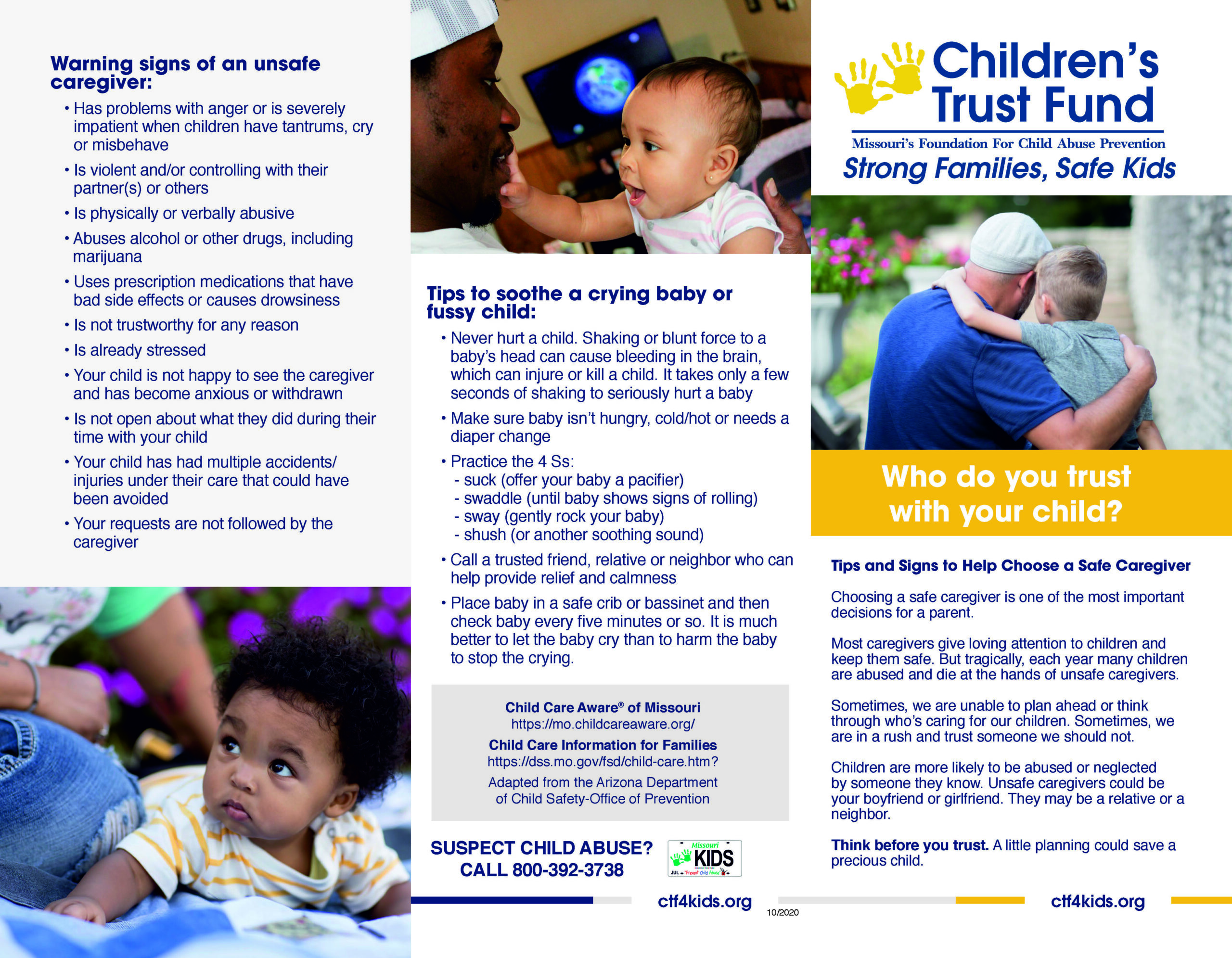Who Do You Trust With Your Child?
Tips and Tips to Help Choose a Safe Caregiver
Choosing a safe caregiver is one of the most important decisions for a parent.
Most caregivers give loving attention to children and keep them safe. But tragically, each year many children are abused and die at the hands of unsafe caregivers.
Sometimes, we are unable to plan ahead or think through who’s caring for our children. Sometimes, we are in a rush and trust someone we should not.
Children are more likely to be abused or neglected by someone they know. Unsafe caregivers could be your boyfriend or girlfriend. They may be a relative or a neighbor.
Think before you trust. A little planning could save a precious child.
(Panel 2) A safe caregiver:
- Has experience caring for babies and young children
- Is patient and mature to care for a fussy, overexcited or crying baby
- Understands that young children must always be watched
- Will be only watching your child or a limited number of children to assure each child receives adequate attention
- Will never shake, hit, yell at, make fun of or withhold food from a child as punishment
- Does not abuse alcohol/drugs or carry a weapon; will not surround a child with others who may be drinking, using or selling drugs, or carrying weapons
- Keeps your child clean and safe and with infrequent accidents/injuries
- Has first aid training
- Talks to you and asks questions; your caregiver should be able to tell you everything your child did and discuss any concerns
- Knows the ABCs of infant safe sleep: Babies should sleep Alone, on their Backs, in a safe Crib with no blankets, bumper pads, toys, pillows or animals
- Is aware of the dangers/risks associated with Abusive Head Trauma (AHT)/Shaken Baby Syndrome (SBS)
(Panel 3) Help your caregiver:
- Reassure your caregiver that it’s OK to call for help if he/she can’t get the infant to stop crying or is feeling frustrated or stressed caring for your child; be sure to provide your contact numbers
- Ensure caregiver has someone else to call for help if the parents are unavailable
- If your child is being cared for in your home, be sure caregiver has your home address for emergency personnel in case of emergency
- Discuss techniques that have effectively soothed your crying infant
- Encourage the caregiver to put your crying baby down in a safe place whenever frustrated and then check on baby every five minutes
- Make your expectations very clear
(Panel 4) General safety tips to consider:
- Does your caregiver:
- get angry or impatient when your child cries or has a tantrum?
- call your child bad names or put down your child?
- think it’s funny to scare your child?
- Lock guns and other weapons in a cabinet
- Obtain references from your caregiver or recommendations from others you trust
- Check your caregiver’s criminal history
Trust your instincts.
(Panel 5) Warning signs of an unsafe caregiver:
- Has problems with anger or is severely impatient when children have tantrums, cry or misbehave
- Is violent and/or controlling with their partner(s) or others
- Is physically or verbally abusive
- Abuses alcohol or other drugs, including marijuana
- Uses prescription medications that have bad side effects or causes drowsiness
- Is not trustworthy for any reason
- Is already stressed
- Your child is not happy to see the caregiver and has become anxious or withdrawn
- Is not open about what they did during their time with your child
- Your child has had multiple accidents/injuries under their care that could have been avoided
- Your requests are not followed by the caregiver
(Panel 6) Tips to soothe a crying baby or fussy child:
- Never hurt a child. Shaking or blunt force to a baby’s head can cause bleeding in the brain, which can injure or kill a child. It takes only a few seconds of shaking to seriously hurt a baby
- Make sure baby isn’t hungry, cold/hot or needs a diaper change
- Practice the 4 Ss:
- suck (offer your baby a pacifier) ● swaddle (until baby shows signs of rolling)
- sway (gently rock your baby) ● shush (or another soothing sound)
- Call a trusted friend, relative or neighbor who can help provide relief and calmness
- Place baby in a safe crib or bassinet and then check baby every five minutes or so. It is much better to let the baby cry than to harm the baby to stop the crying.
Adapted from the Arizona Department of Child Safety-Office of Prevention
Suspect Child Abuse? Call 1-800-392-3738
Resources
CTF Online Literature Order Form
Child Care Aware of Missouri > https://mo.childcareaware.org/
Child Care Information for Families > https://dss.mo.gov/fsd/child-care.htm?

